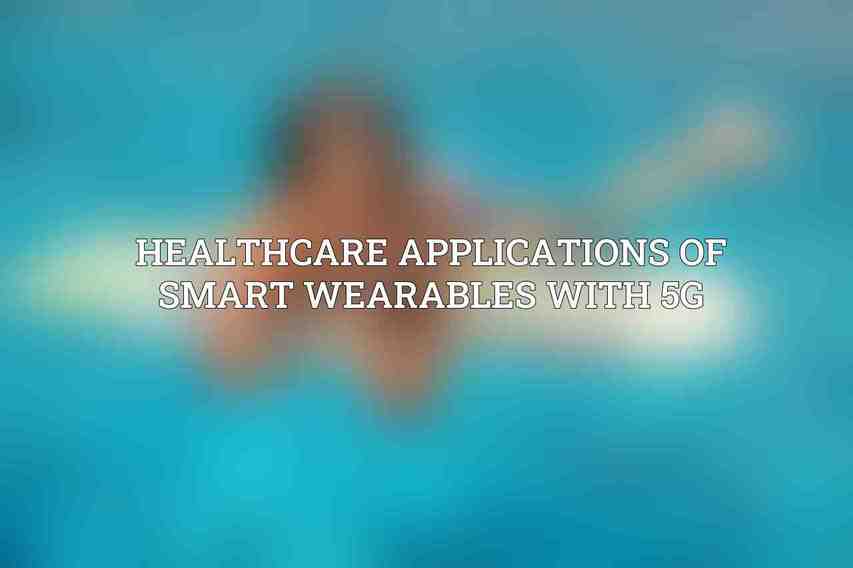The synergy between 5g connectivity and smart wearables has opened up a realm of possibilities, revolutionizing the way we interact with technology on a daily basis. Smart wearables, encompassing a wide range of devices like smartwatches, fitness trackers, and health monitors, have become indispensable companions that provide us with valuable insights into our health and well-being. The advent of 5G technology has further accelerated the capabilities of these wearables, offering faster connectivity, reduced latency, and expanded functionality.
5G’s Impact on Smart Wearable Functionality
The integration of 5G technology has significantly enhanced the functionality of smart wearables across various domains, from health and fitness tracking to entertainment and communication. The key aspects where 5G has made a substantial impact include:
Increased Data Transmission Speed
One of the primary advantages of 5G for smart wearables is the increased data transmission speed, facilitating quicker exchange of information between devices and servers. This enhancement has enabled:
- Faster download and upload of health and fitness data: Users can seamlessly sync their workout routines, health metrics, and progress with fitness apps and cloud platforms.
- Real-time monitoring and analysis of vital signs: Health monitoring devices can transmit data instantly, allowing for immediate analysis of vital signs such as heart rate, blood pressure, and oxygen levels.
Reduced Latency
5G technology has also brought about reduced latency, leading to faster response times and more seamless user experiences. This improvement is particularly beneficial for:
- Improved response time for medical emergencies: Wearable devices can quickly send distress signals or health alerts in critical situations, enabling prompt assistance.
- Enhanced gaming and entertainment experiences: Gamers can enjoy real-time multiplayer games and immersive virtual reality experiences without lags or delays.
Wider Bandwidth
With 5G‘s wider bandwidth, smart wearables can support a greater number of sensors and advanced features, paving the way for innovative applications and services. This advancement has enabled:
- Support for multiple sensors and advanced features: Wearables can now integrate a range of sensors for tracking various health parameters and activities simultaneously.
- Enablement of immersive virtual and augmented reality applications: Users can delve into interactive AR/VR experiences seamlessly on their wearables, enhancing entertainment and productivity.
Healthcare Applications of Smart Wearables with 5G

Revolutionizing patient care and wellness management. some of the notable healthcare applications enabled by this synergy include:
Remote Patient Monitoring
5G-enabled smart wearables have empowered healthcare providers to engage in remote patient monitoring, facilitating continuous tracking of vital signs and health parameters. This capability has led to:
- Continuous monitoring of vital signs and health parameters: Patients can be monitored round-the-clock, offering a comprehensive view of their health status.
- Early detection and prevention of health issues: Abnormalities in vital signs can trigger timely interventions, preventing potential health complications.
Telemedicine and Virtual Consultations
The combination of smart wearables and 5G connectivity has facilitated telemedicine practices, allowing for virtual consultations and healthcare services irrespective of geographical barriers. This advancement has enabled:
- Real-time video conferencing with healthcare professionals: Patients can consult with doctors and specialists remotely through high-quality video calls, ensuring prompt medical attention.
- Remote diagnosis and treatment plans: Healthcare providers can assess patients, diagnose conditions, and create treatment strategies remotely, improving accessibility to healthcare services.
Personalized Healthcare
5G-enabled smart wearables personalize healthcare experiences by tailoring recommendations and interventions based on individual health data. This level of personalization has led to:
- Wearables track individual health patterns and provide tailored recommendations: Users receive customized insights and suggestions for improving their health and well-being.
- Precision medicine and targeted therapies: Healthcare providers can leverage precise health data from wearables to administer personalized treatment plans and interventions, optimizing patient outcomes.
Specific Examples of Smart Wearables Leveraging 5G
Several smart wearable devices have embraced 5G connectivity to deliver enhanced features and services that cater to diverse user needs. Let’s explore some specific examples of smart wearables that leverage 5G technology:
| Smart Wearable | Key Features |
|---|---|
| OnePlus 12R | – Snapdragon 8 Plus Gen 1 processor – 8GB/12GB RAM – 128GB/256GB storage – Advanced health-tracking sensors |
| Apple Watch Series 8 | – S8 chip – 18-hour battery life – Always-On display – Comprehensive health monitoring capabilities |
| Fitbit Versa 4 | – GPS – 24/7 heart rate tracking – Sleep tracking – Advanced activity tracking with Active Zone Minutes |
The OnePlus 12R, Apple Watch Series 8, and Fitbit Versa 4 exemplify the synergy between 5G connectivity and smart wearables, offering a plethora of features ranging from advanced health tracking to seamless connectivity for various activities.
Stay tuned for part two where we will delve deeper into the future prospects and challenges associated with the integration of 5G technology in smart wearables, exploring emerging trends, regulatory considerations, and the path forward in this dynamic technological world.
Frequently Asked Questions
What are smart wearables?
Smart wearables are electronic devices that can connect to the internet and perform various functions beyond traditional wearable devices, such as tracking fitness data, receiving notifications, and providing health monitoring.
How does 5G technology enhance smart wearables?
5G technology significantly improves the speed, latency, and connectivity of smart wearables, allowing for faster data transmission, reduced lag time, and more efficient communication between devices and servers.
Can 5G support the large amount of data generated by smart wearables?
Yes, 5G networks are designed to handle high data loads from various connected devices, making them ideal for supporting the extensive data produced by smart wearables.
What are some examples of smart wearables that can benefit from 5G technology?
Examples include smartwatches, fitness trackers, augmented reality glasses, and health monitoring devices, all of which can benefit from the improved speed and connectivity offered by 5G technology.
Are there any drawbacks to using 5G with smart wearables?
While 5G technology offers numerous benefits, potential drawbacks may include increased power consumption in devices due to faster data transmission and the need for compatible 5G infrastructure in all areas for seamless connectivity.
